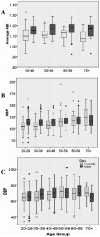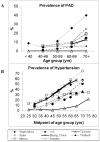Inflammation and infection do not promote arterial aging and cardiovascular disease risk factors among lean horticulturalists - PubMed (original) (raw)
Inflammation and infection do not promote arterial aging and cardiovascular disease risk factors among lean horticulturalists
Michael Gurven et al. PLoS One. 2009.
Abstract
Background: Arterial aging is well characterized in industrial populations, but scantly described in populations with little access to modern medicine. Here we characterize health and aging among the Tsimane, Amazonian forager-horticulturalists with short life expectancy, high infectious loads and inflammation, but low adiposity and robust physical fitness. Inflammation has been implicated in all stages of arterial aging, atherogenesis and hypertension, and so we test whether greater inflammation associates with atherosclerosis and CVD risk. In contrast, moderate to vigorous daily activity, minimal obesity, and low fat intake predict minimal CVD risk among older Tsimane.
Methods and findings: Peripheral arterial disease (PAD), based on the Ankle-Brachial Index (ABI), and hypertension were measured in Tsimane adults, and compared with rates from industrialized populations. No cases of PAD were found among Tsimane and hypertension was comparatively low (prevalence: 3.5%, 40+; 23%, 70+). Markers of infection and inflammation were much higher among Tsimane than among U.S. adults, whereas HDL was substantially lower. Regression models examine associations of ABI and BP with biomarkers of energy balance and metabolism and of inflammation and infection. Among Tsimane, obesity, blood lipids, and disease history were not significantly associated with ABI. Unlike the Tsimane case, higher cholesterol, C-reactive protein, leukocytes, cigarette smoking and systolic pressure among North Americans are all significantly associated with lower ABI.
Conclusions: Inflammation may not always be a risk factor for arterial degeneration and CVD, but instead may be offset by other factors: healthy metabolism, active lifestyle, favorable body mass, lean diet, low blood lipids and cardiorespiratory health. Other possibilities, including genetic susceptibility and the role of helminth infections, are discussed. The absence of PAD and CVD among Tsimane parallels anecdotal reports from other small-scale subsistence populations and suggests that chronic vascular disease had little impact on adult mortality throughout most of human evolutionary history.
Conflict of interest statement
Competing Interests: The authors have declared that no competing interests exist.
Figures
Figure 1. Median and interquartile values of (A) ABI (averaged across left and right sides), (B) systolic BP and (C) diastolic BP, for Tsimane by age group and sex.
Figure 2. Prevalence of (A) Peripheral Arterial Disease (ABI<0.9) and (B) Hypertension (SBP≥140 and/or/ DBP>−90), among Tsimane and other populations.
Data sources for ABI: urban China , urban Mexico , South Africa , southeast Spain , Sweden (Sigvant Birgitta pers comm), Thailand , United States . Hypertension data for the same countries come from the World Health Organization Global Infobase,
http://www.who.int/infobase/report.aspx
. Note: x-axis represents midpoints of age intervals because of the different age intervals reported among studies (e.g. 30–39 vs. 35–44); Hypertension defined as SBP≥140 and/or DBP≥90 except for Sweden where SBP≥160 and/or DBP≥95.
Figure 3. Comparison of cardiovascular disease risk factors among Tsimane and United States adults.
Mean levels of (A) C-reactive protein (CRP, mg/L), (B) white blood cell (WBC) count (cells/mm3), (C) body mass index (BMI,kg/m2), (D) total and HDL cholesterol (mg/dL). Total cholesterol correlates strongly with low-density lipoprotein (LDL) among both Tsimane (r = .82, p<.0001) and US (r = .91, p<.0001), and with triglycerides (Tsimane: r = .48, p<.0001; US: r = .43, p<.0001), and so are not illustrated here. See Table 6 for further details.
Similar articles
- APOE4 is associated with elevated blood lipids and lower levels of innate immune biomarkers in a tropical Amerindian subsistence population.
Garcia AR, Finch C, Gatz M, Kraft T, Eid Rodriguez D, Cummings D, Charifson M, Buetow K, Beheim BA, Allayee H, Thomas GS, Stieglitz J, Gurven MD, Kaplan H, Trumble BC. Garcia AR, et al. Elife. 2021 Sep 29;10:e68231. doi: 10.7554/eLife.68231. Elife. 2021. PMID: 34586066 Free PMC article. - Coronary atherosclerosis in indigenous South American Tsimane: a cross-sectional cohort study.
Kaplan H, Thompson RC, Trumble BC, Wann LS, Allam AH, Beheim B, Frohlich B, Sutherland ML, Sutherland JD, Stieglitz J, Rodriguez DE, Michalik DE, Rowan CJ, Lombardi GP, Bedi R, Garcia AR, Min JK, Narula J, Finch CE, Gurven M, Thomas GS. Kaplan H, et al. Lancet. 2017 Apr 29;389(10080):1730-1739. doi: 10.1016/S0140-6736(17)30752-3. Epub 2017 Mar 17. Lancet. 2017. PMID: 28320601 Free PMC article. - Patterns of senescence in human cardiovascular fitness: VO2 max in subsistence and industrialized populations.
Pisor AC, Gurven M, Blackwell AD, Kaplan H, Yetish G. Pisor AC, et al. Am J Hum Biol. 2013 Nov-Dec;25(6):756-69. doi: 10.1002/ajhb.22445. Epub 2013 Sep 10. Am J Hum Biol. 2013. PMID: 24022886 Free PMC article. - Behavioral Counseling to Promote a Healthful Diet and Physical Activity for Cardiovascular Disease Prevention in Adults Without Known Cardiovascular Disease Risk Factors: Updated Systematic Review for the U.S. Preventive Services Task Force [Internet].
Patnode CD, Evans CV, Senger CA, Redmond N, Lin JS. Patnode CD, et al. Rockville (MD): Agency for Healthcare Research and Quality (US); 2017 Jul. Report No.: 15-05222-EF-1. Rockville (MD): Agency for Healthcare Research and Quality (US); 2017 Jul. Report No.: 15-05222-EF-1. PMID: 29364620 Free Books & Documents. Review. - The Ankle Brachial Index for Peripheral Artery Disease Screening and Cardiovascular Disease Prediction in Asymptomatic Adults: A Systematic Evidence Review for the U.S. Preventive Services Task Force [Internet].
Lin JS, Olson CM, Johnson ES, Senger CA, Soh CB, Whitlock EP. Lin JS, et al. Rockville (MD): Agency for Healthcare Research and Quality (US); 2013 Sep. Report No.: 12-05162-EF-1. Rockville (MD): Agency for Healthcare Research and Quality (US); 2013 Sep. Report No.: 12-05162-EF-1. PMID: 24156115 Free Books & Documents. Review.
Cited by
- Physiological Differences Across Populations Reflecting Early Life and Later Life Nutritional Status and Later Life Risk for Chronic Disease.
Crimmins EM. Crimmins EM. J Popul Ageing. 2015 Mar;8(1-2):51-69. doi: 10.1007/s12062-014-9109-4. J Popul Ageing. 2015. PMID: 25750688 Free PMC article. No abstract available. - Early environments and the ecology of inflammation.
McDade TW. McDade TW. Proc Natl Acad Sci U S A. 2012 Oct 16;109 Suppl 2(Suppl 2):17281-8. doi: 10.1073/pnas.1202244109. Epub 2012 Oct 8. Proc Natl Acad Sci U S A. 2012. PMID: 23045646 Free PMC article. Review. - Infant and fetal mortality among a high fertility and mortality population in the Bolivian Amazon.
Gurven M. Gurven M. Soc Sci Med. 2012 Dec;75(12):2493-502. doi: 10.1016/j.socscimed.2012.09.030. Epub 2012 Oct 10. Soc Sci Med. 2012. PMID: 23092724 Free PMC article. - Evidence for height and immune function trade-offs among preadolescents in a high pathogen population.
Garcia AR, Blackwell AD, Trumble BC, Stieglitz J, Kaplan H, Gurven MD. Garcia AR, et al. Evol Med Public Health. 2020 Sep 2;2020(1):86-99. doi: 10.1093/emph/eoaa017. eCollection 2020. Evol Med Public Health. 2020. PMID: 32983534 Free PMC article. - Pathogenic and obesogenic factors associated with inflammation in Chinese children, adolescents and adults.
Thompson AL, Houck KM, Adair L, Gordon-Larsen P, Du S, Zhang B, Popkin B. Thompson AL, et al. Am J Hum Biol. 2014 Jan-Feb;26(1):18-28. doi: 10.1002/ajhb.22462. Epub 2013 Oct 7. Am J Hum Biol. 2014. PMID: 24123588 Free PMC article.
References
- Gurven M, Kaplan H, Zelada Supa A. Mortality experience of Tsimane Amerindians: regional variation and temporal trends. American Journal of Human Biology. 2007;19:376–398. - PubMed
- Sacks D, Bakal CW, Beatty PT, Becker GJ, Cardella JF, et al. Position statement on the use of the ankle brachial index in the evaluation of patients with peripheral vascular disease. A consensus statement developed by the Standards Division of the Society of Interventional Radiology. J Vasc Interv Radiol. 2003;14:S389. - PubMed
- Feringa HH, Bax JJ, van Waning VH, Boersma E, Elhendy A, et al. The long-term prognostic value of the resting and postexercise ankle-brachial index. Arch Intern Med. 2006;166:529–535. - PubMed
- Wild SH, Byrne CD, Smith FB, Lee AJ, Fowkes FG. Low ankle-brachial pressure index predicts increased risk of cardiovascular disease independent of the metabolic syndrome and conventional cardiovascular risk factors in the Edinburgh Artery Study. Diabetes Care. 2006;29:637–642. - PubMed
- Eldrup N, Sillesen H, Prescott E, Nordestgaard BG. Ankle brachial index, C-reactive protein, and central augmentation index to identify individuals with severe atherosclerosis. European Heart Journal. 2006;27:316–322. - PubMed
Publication types
MeSH terms
Grants and funding
- T32 AG0037/AG/NIA NIH HHS/United States
- T32 AG000037/AG/NIA NIH HHS/United States
- R01 AG024119/AG/NIA NIH HHS/United States
- P30 AG17265/AG/NIA NIH HHS/United States
- P30 AG017265/AG/NIA NIH HHS/United States
- R01 AG024119-01/AG/NIA NIH HHS/United States
- R21 AG031988/AG/NIA NIH HHS/United States
LinkOut - more resources
Full Text Sources
Research Materials


